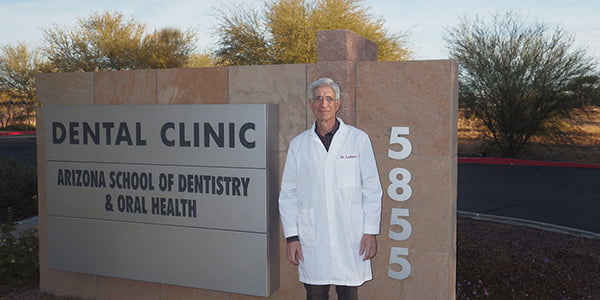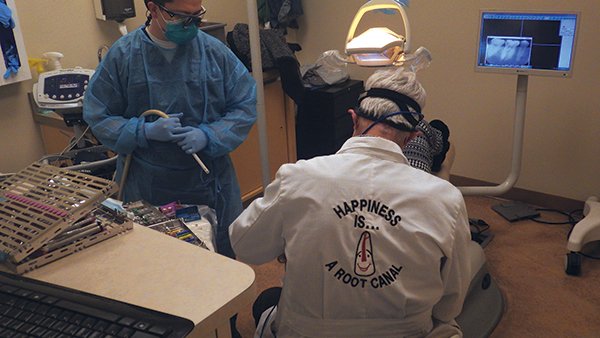The fine art of endodontics


What can you tell us about your background?
I graduated from Indiana University Dental School in 1974 and then Boston University of Graduate Dentistry under the guidance of Dr. Herbert Schilder in 1976 with a master’s degree in endodontics.
I moved to Phoenix, Arizona, in 1976 and started private practice. I was the fifth-trained endodontist to start a practice in the state of Arizona. I practiced full-time and began teaching as needed in 2003 at the Arizona School of Dentistry and Oral Health (ASDOH) in Mesa, Arizona. When the clinic opened in 2005, I closed my practice and went to work for Roda and Sluyk Endodontics 2 days a week and taught in the clinic at ASDOH 3 days a week as co-director of endodontics, instructing students in the pre-doctoral endo clinic. In 2010, when one of my predoctoral students finished his residency in endodontics, I left the practice and became a full-time instructor at ASDOH, where I continue to teach today. I am responsible for all the preclinical didactic education, and my co-director, Gene Jasper, and four other endodontists oversee all the clinical endodontic treatment.
What originally attracted you to the specialty of endodontics?
I was attracted to endodontics because of control. I realized in dental school that you could do great work, and then the patient went home and a spouse or visiting relative would say, “Your teeth look ugly,” and it was back to the drawing board trying to please. Lab work was fun, but after talking to many dentists and as a student, I realized that labs could make mistakes, and work then needed to be redone. Dealing with esthetics and labs took away control. In endodontics, most patients expect the worst event of their dental experience. “There’s nothing worse than a root canal,” or “the last root canal I had was horrible.” So if the patient does have problems, then you live up to their expectations. However, most of the time, the procedure and postoperative discomfort is uneventful, and then you exceed their expectations. I have never had a patient come back to the office saying my Aunt Mary was visiting, and she thinks my root canal doesn’t look good. If you do a good job of diagnosing and treatment, you will win most of the time. I am also very focused, and endodontics fits that portion of my personality.
Top 10 favorites
- My wife
- My standard poodles, George and Gracie
- My Corvette
- My life
- Arizona School of Dentistry and Oral Health
- Dentsply Tulsa Dental Specialties for all they do
- Vortex Blue® files
- Brasseler USA® EndoSequence® for pulp capping and root repair
- Photography
- Design For Vision loupes

What aspects of your training inspired you to add “educator” to your list of accomplishments?
Initially, I did not have a desire to become an educator. After being in practice for several years, I came to the realization that I wanted to give back. The opportunity came when Dr. Dillenberg, the Dean of ASDOH, contacted me about the new school and asked me to teach endodontics at the school. At first I said no, but after discussing the opportunity with the Dean and my wife, I agreed. Teaching would be a wonderful way to pass on my knowledge and a positive way to end a wonderful career. And so far, it has been a rewarding and great experience.
Who has inspired you as a clinician and an educator?
My mentor, Dr. Herbert Schilder, was a great inspiration in my becoming a teacher. He was a phenomenal person who instilled in his students the drive to be the best and to give back when the opportunity presented itself. In his last days, I met with him at his home in Boston; the smile and look on his face when I told him I was going to pass along his wisdom was a moment I will never forget. He was truly an inspiring individual.
What are your proudest moments in the clinical and teaching aspects of your life?
I am most proud of the accomplishments of the students from ASDOH. They perform well in regional board exams in the area of endodontics and continue to share with me cases they have completed. The students are comfortable in calling or emailing me with questions and asking for advice after graduation. The fact that they trust me and know that I am there for them is very rewarding and satisfying. I am most happy when I hear that one of the students gets accepted into a residency program in endodontics. For the most part, dealing with these young clinicians keeps me connected and up-to-date. Learning never ceases. The students have taught me not to be judgmental, to be patient, and not jump to conclusions as rapidly as I use to.
What has been your biggest challenge in sharing information and educating endodontists?
Since I am not educating endodontists, but soon-to-be general dentists, the challenge is to make them understand what cases they should do, and when is it appropriate to refer. I explain to them over the years that one of the most difficult situations is when the young dentist who is trying to grow a practice treats a complex case, has problems, and ultimately, makes a referral to a specialist after several visits. As an endodontist, I would see that patient, fix the problem, and finish the case in one, or maybe two, visits. The patient would then ask why the general dentist didn’t refer them right away. Then they do not want to go back to that practice and ask for the name of another dentist. Rarely could I talk them out of it.
What would you have become if you had not become a dentist?
I have no idea what I would have done if I hadn’t become a dentist. I just knew I needed to probably work for myself and have some control. Besides dentistry, I have a fine art photography business and sell art to dental practices for their offices and participate in some art fairs along with my wife who is an oil painter.
What are your top tips for maintaining a successful practice?
To maintain a successful practice is all about relationships with both referring doctors and patients. When a patient trusts you, you can accomplish a great deal. Call patients in the evening to see how they are doing, and let them know you care. Don’t sell dentistry; let the patients decide. I never told a patient, if they asked, what I would do if I was the patient in the chair; I just advised them of all the possibilities and problems and let them decide. If I wouldn’t do it to myself, then I would never even offer that procedure as a possibility to the patient. When I took dentists out to lunch or met with them socially, I tried not to talk about just dentistry, and what I could do for them; I would try to get to know them better and build a relationship.
Learning never ceases. The students have taught me not to be judgmental, to be patient, and not jump to conclusions …
What are a few of your “tried-and-true” materials and/or equipment?
There are many different endodontic systems available today. My job is to pick a system and teach it to the students, make them proficient, and give them a good foundation to expand upon. As systems improve, we may over the course of a few years change instrumentation, but this proves to be costly if we have a large supply of files on hand. We recently began using Vortex Blue® (Dentsply Tulsa Dental Specialties) Rotary Files and are having great success. We have classes and lab sessions utilizing carrier-based obturation, so the students are familiar with the right and wrong way to utilize this technique. In our clinic, we use warm vertical condensation. The challenge is to stay current and be conscious of budget constraints. Also, in the fourth year after students fulfill their endo obligations to graduate, we will introduce them to WaveOne® reciprocation technology, if the opportunity arises.
When I started teaching at ASDOH, Dentsply stepped up to the plate. They provided many educational opportunities and connections for me to start the program. We use Vortex Blue as our file system and AH Plus® ribbon as a sealer. This has increased the proficiency of the case for students, and they enjoy working with it. Although we have MTA and use it for some repair procedures, we also use EndoSequence® pulp capping and apex putty (Brasseler USA®) for its ease-of-use and predictability. Dentsply has gone the extra mile for providing help and educational materials to make our program successful. The ProMark® Endodontic Motor is great. It allows both reciprocation and conventional rotary instrumentation.

Stay Relevant With Endodontic Practice US
Join our email list for CE courses and webinars, articles and more..


